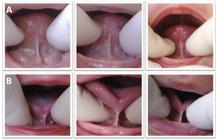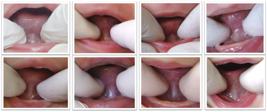ABSTRACT
Purpose:
to verify the occurrence of posterior or submucosal lingual frenulum and evaluate the efficiency of a special maneuver for its visual inspection.
Methods:
an experimental study including 1,715 healthy infants, in which prematurity, perinatal complications, craniofacial anomalies neurological disorders, and visible genetic syndromes were the exclusion criteria. A clinical examination was performed by means of a maneuver that consisted in rising the lateral margins of the tongue to visualize the anatomical characteristics of the lingual frenulum. In some of the infants, a special maneuver was performed to assist visualization of posterior lingual frenulum, since its visualization was not possible. The maneuver consisted in two simultaneous actions: elevating and pushing the tongue back.
Results:
558 infants (32.54%), out of the 1,715 had posterior frenulum, which required the special maneuver that consisted in both elevating and pushing the tongue back, simultaneously.
Conclusion:
the occurrence of posterior lingual frenulum was high and the special maneuver consisted in elevating and pushing the tongue back proved to be efficient to visualize the posterior lingual frenulum.
Keywords:
Lingual Frenulum; Speech, Language and Hearing Sciences; Anatomy, Ankyloglossia; Tongue

 Thumbnail
Thumbnail
 Thumbnail
Thumbnail
 Thumbnail
Thumbnail


